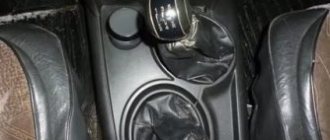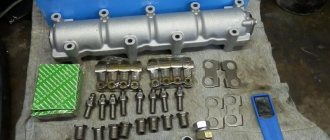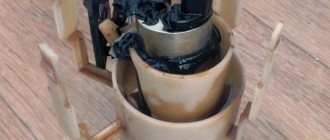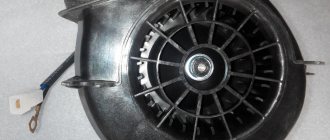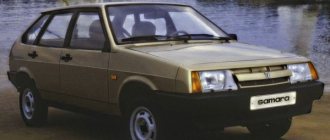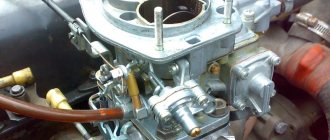- December 10, 2019
- Cars
- Vladimir Skvortsov
The favorite car of fishermen and hunters is the Niva. And the reason for this attitude is the opportunity with its help to get to remote and rarely visited places. What allows you to achieve such results? There is a lock on the Niva. How it helps and in what ways will be discussed below.
About the transmission
First of all, a few words about the structure of the Niva. It has permanent all-wheel drive. What does it mean? It's simple - torque is simultaneously transmitted to four wheels. This is one of the fundamental differences between the Niva and other cars. They supply torque to only one of the axles (front or rear).
All-wheel drive is implemented through the use of a transfer case. The torque, having passed through the gearbox, goes to the transfer case, and from it to the front and rear axles. This design makes it possible to create a locking center differential on the Niva, which, together with all-wheel drive, provides it with increased cross-country ability. Here it is necessary to say a few words about the differential. Largely thanks to him, the excellent off-road characteristics of the Niva are realized.
Reduction gearboxes of Niva 4x4, as well as Chevrolet
In addition to the center differential, the transfer case has a so-called reduction gearbox. Actually, the transfer cases of these SUVs are dual-mode boxes. In this case, the first mode provides a gear ratio at the gearbox equal to 1.25, and the second – 2.135.
It turns out that the total gear ratios are the results of the transfer case gear ratios and the corresponding gearbox speed multiplied together, which is reflected in the table below:
| Transfers | Gearbox + transfer case (1st mode) | Gearbox + transfer case (2nd mode) |
| I | 4,40 | 7,83 |
| II | 2,52 | 4,48 |
| III | 1,63 | 2,90 |
| IV | 1,20 | 2,14 |
| V | 0,98 | 1,75 |
| R | 4,24 | 7,54 |
The result of using lower gears is such that in the same gear at the gearbox with a reduced mode on the transfer case, the speeds decrease, but the traction forces increase.
Understanding the differential
This device allows the car to move freely in a given direction. When turning, the left and right wheels of the car travel different paths. And if they are rigidly connected, then one will slip and the other will slow down. In addition, in this case, the load on the axle increases sharply, which will result in its breakdown or excessive wear of the rubber.
The differential allows you to cope with this problem. On conventional cars it is located on the axle between the wheels, allowing them to rotate independently of each other. The differential distributes the torque received by it between the wheels, and not in equal proportions, but depending on the driving conditions of each - one more, one less.
The same applies to axles in general (front and rear). Their movement, for example when turning, also differs. To distribute forces, a so-called center differential is used. Thanks to it, depending on driving conditions, the torque transmitted to the front and rear axles will differ.
Transfer case purpose
The key purpose of the unit is to distribute the moment of force of the internal combustion engine to the wheel axles. Simply put, the multiplier directs the required force to each axis during movement. This is expressed as follows:
- Niva 2121 transfer case simplifies movement on off-road and unstable soils;
- blocks the center differential;
- disabling one of the vehicle's axles;
- increasing the torque of the driving pair of wheels;
- installation of power take-off for additional equipment.
Features of differential operation
The moment is distributed in such a way that it is transferred to where the load is less. This can be confirmed by the usual picture - the car has three wheels on the asphalt, and one on the ice. She fails to move. The friction force of rubber on ice is much less than that of rubber on asphalt, which means that the load on a wheel standing on ice is less than on others.
And the differential transmits all the torque towards the minimum load. As a result, one wheel rotates at breakneck speed, while the rest stand still and the car does not move. The situation is approximately the same when a car cannot climb a mountain on an icy road. In this case, one wheel caught on ice spins, but the car stops.
Work that no one needs is being done. The wheel “grinds” the road surface (ice). Getting rid of such useless work is blocking both on the Niva and on any other car adapted to difficult roads. But usually the devices described are not available on all machines.
Possible problems
Quite often, car owners do not know how to use the transfer case on a Niva, and may encounter the fact that the center lock does not turn off, and they have to drive along the highway in this mode, which negatively affects the car. In order to switch the transmission to normal mode, you need to switch to reverse gear and accelerate a little, and while reversing, try to dislodge the lock. If this doesn't work, you can try to do the same thing, only while moving forward.
To avoid transmission problems, Niva car owners must adhere to the following rules:
Here are the basic rules by following which you can significantly extend the life of the gearbox on a Chevrolet Niva.
Sometimes there is a knocking sound in the transfer case. The Chevrolet Niva is a more reliable car than the VAZ-2121, but such malfunctions should not be ruled out. The first thing you should pay attention to is the driveline. Previously, Nivas had crosses, the play in which caused a lot of noise and vibration.
What are the types of blocking?
Usually there are two types - inter-wheel and inter-axle. The first ones block the operation of the differential installed between the wheels on one axis. The purpose of the interaxle blocking is to ensure the distribution of forces between the axles.
The Niva has three differentials, a center differential and two cross-axle differentials. But they are fundamentally different. If the inter-axle differentials are free, there are no additional devices on them, then the inter-axle differential has a forced lock. It greatly facilitates the movement of the vehicle in off-road conditions, partially giving it the capabilities of an all-terrain vehicle.
Driving a car
| GENERAL INFORMATION |
SHIFTING GEARS OF A MANUAL TRANSMISSION
To engage 5th gear, you must move the lever to the right, overcoming resistance, then move it forward. Reverse gear is engaged only when the car is stationary and not earlier than three seconds after squeezing the clutch pedal.
| The position diagram of the manual transmission control lever is printed on top of its handle. |
| EXECUTION ORDER |
| 1. Overcoming resistance, move the lever to the right, then move it back. |
| 2. If you cannot select the desired gear, return the lever to neutral, release the clutch pedal, then depress it again and try to select a gear again. |
SWITCHING TRANSFER CASE MODES
Using the transfer case control lever, the driver can choose between normal and all-wheel drive driving modes.
| When selecting the all-wheel drive mode (“4H” or “4l”), the warning lamp (16) lights up on the vehicle’s instrument panel. |
The transfer case does not have a neutral position, so its control lever must always be securely installed in one of the possible three positions (“2h”, 4H or “4l”). The “2H” mode is designed for vehicle movement on normal road surfaces, providing maximum fuel economy and minimal background noise. When turning on this mode, you must disable the manual locking of the front wheel hubs (models with manual locking of the hubs - see below). The “4H” mode provides optimal conditions for driving on wet or icy road surfaces. Don't forget to turn on the manual locking of the front wheel hubs. The vehicle speed should not exceed 100 km/h (60 mph). The “4l” mode provides maximum engine output power and is intended for use when driving a vehicle in mountainous terrain, off-road, sand, mud or deep snow. Manual locking of the front wheel hubs must be turned on. The vehicle speed should not exceed 40 km/h (25 mph). Shifting the transfer case control lever does not require depressing the clutch pedal. Switching from the “2H” mode to the “4H” mode on the move is only possible if the manual locking of the front wheel hubs is already turned on (models with manual hub locking). Warning
Under no circumstances switch the transfer case from the “2H” mode to the “4H” mode while driving if the manual or automatic locking of the front wheel hubs is not enabled! The gearbox can be switched from “4H” mode to “2H” mode at any vehicle speed, without the need to depress the clutch pedal. Warning
Switching the transfer case from the “4H” mode to the “4l” mode and back should only be done with the vehicle stationary! Models with automatic front wheel hub locking
| Possible positions of the control lever are indicated on the top of its handle. | The front wheel hubs of such models are marked accordingly. |
| EXECUTION ORDER |
| 1. To engage the hub lock, stop the vehicle and move the transfer case control lever to the “4h” or “4l” position. |
| 2. The blocking will occur automatically when the car starts moving. Comment |
Even if the lever is turned to the “2h” position, the hubs will remain locked until the direction of travel is changed.
When the transfer case is turned on in the “4h” or “4l” mode, the hub locking is turned off instantly and turns back on when the direction of movement changes.
Models with manual hub locking
To disengage the clutch lock, turn it counterclockwise and bring it to the “free” position (see ibid.).
FEATURES OF DRIVING 4WD VEHICLES
Driving on the highway in the cold season
The increased traction of all-wheel drive models provides the vehicle with better handling when driving in difficult road conditions, particularly in deep snow and heavy icing. However, all-wheel drive does not provide anti-skid protection in any way. Moreover, it is often easier to get a rear-wheel drive or front-wheel drive car out of a skid than in the case of 4wd models. In view of the above, you should not abuse the inclusion of all-wheel drive modes when driving on shallow snow or ice crust. – Depending on the specific conditions, switch the transfer case to the “4l” or “2h” mode; – Start the engine, engage a low gear and start moving at the lowest possible speed, manipulating the gas and clutch pedals; – Try to avoid excessive clutch slipping; – Try to shift the transmission into higher gear as quickly as possible and make sure that the engine speed does not increase excessively.
Off-road driving
When the deterioration of the road surface makes it necessary to engage the all-wheel drive mode, try to comply with the following basic requirements: – Drive reasonably slowly, in low gears, taking into account the road and weather conditions; – To drive the car, try to use the gas pedal, minimizing the use of the brakes; – Try to avoid slipping of the clutch and turning the wheels; – Avoid sharp turns of the steering wheel. Try to take into account all weather and road factors - use common sense and try to soberly assess the capabilities of the car. Before you go on a long trip, plan your route in advance. Before departure, check the technical condition of the car.
OVERCOMING WATER OBSTACLES
Try not to go into deep water. Before starting the crossing, study the bottom relief of the obstacle and choose the most gentle entry into the water. Switch the transfer case to the “4l” position and engage first gear. Try not to allow the engine speed to jump to prevent water from entering the exhaust system if the exhaust pipe cut is below the surface. Drive at a speed of no more than 5 km/h (3 mph) and try not to create a lot of splashes. Try not to move against the current. If this is not possible, try to turn the car at such an angle to the current vector that the incoming water does not pour into the engine compartment. Avoid splashing into the engine compartment to prevent engine shutdown due to moisture in the ignition system components. Make sure that water does not get into the engine air intake, as this can lead to jamming and the need for expensive repairs. After successfully overcoming a water obstacle, check the proper functioning of the brakes. To speed up the drying of the working surfaces of the brake mechanisms, slow down the car several times while driving at low speed. As soon as possible, check whether water has entered the air cleaner filter element, the engine, transmission, axle housings, or the vehicle interior. Replace any lubricants that have acquired a milky consistency, which is evidence of water getting into the oil.
How does the differential lock work on the Niva, the principle of operation
When driving on a normal road, torque is distributed relatively evenly between all wheels. But off-road, in the mud, this is not enough. A simple situation - the car has skidded, for example the left rear wheel. Then all the torque will go there, and the car will not be able to drive. In such a situation, no all-wheel drive will help.
But there is a way out. You need to turn on the center lock. How does such a device work on Niva? The transfer case has a special clutch. When the lock is activated, it connects the shafts that transmit torque to the axles. Let's just say that the force produced by the engine is forcibly divided equally between them. Thus, the entire moment does not go to the slipping wheel, but part of it goes to the front axle (in our example).
Now the four-wheel drive starts working. When the locking is on, the front axle is forced to receive half the torque produced by the engine. Thanks to this, the car starts to move. As soon as it starts moving, the slipping of the rear wheel will stop, and torque will flow to all the others. Then the Niva will safely overcome the difficult section.
It should be noted that the Lada 4x4 car is not the only owner of the described device. A similar differential lock works both on the Chevrolet Niva and on other SUV models, however, it can be implemented in different ways. But nevertheless it performs similar tasks.
Feedback and questions
VAZ 2121 or Lada 4x4 has been produced since 1977. During the entire production period, the body of the SUV changed slightly, and the interior was modified, for example, changes concerned the instrument panel. Let's look at the types of Lada 4×4 dashboards and their descriptions.
The most common instrument combinations (catalog numbers):
- 2121-5325120 - the very first model;
- 21213-3801010 - intermediate model;
- 21150-3801010 - modern model.
Despite the fact that the instrument panels are different, the indicators showing the status of the vehicle systems remain unchanged and are divided by color:
- Green and blue lamps are informational;
- Yellow lamps are informative (Attention!);
- Red lights are emergency lights, movement is prohibited!
Let's look at the description of the instrument panel using the latest VAZ 21214 model as an example.
- coolant temperature indicator. Red zone - engine overheating. When the arrow reaches it, you must stop the car, turn off the engine and check the serviceability of the cooling system;
- tachometer. Shows crankshaft rotation speed. Do not allow the arrow to go into the red zone;
- left turn indicator. Lights up when the left turn signal is turned on;
- right turn indicator. Lights up when the right turn signal is turned on;
- speedometer. Shows the actual speed of the SUV;
- fuel level in the gas tank. 0 - the tank is empty; 1/2 - half of the fuel tank; 1 — full gas tank;
- Fuel reserve indicator lights up when there is less than 9.5 liters of gasoline left in the fuel tank. Do not let the fuel run out, this may damage the fuel pump;
- indicator for turning on external lighting. Lights up when the exterior lighting is turned on;
- low brake fluid level indicator. Lights up when the brake fluid level in the reservoir is below the minimum allowable level. Driving with this lamp on is prohibited;
- high beam headlight indicator. Lights up when switching the headlights from low to high;
- daily mileage reset button;
- odometer display. The upper numbers are the total mileage of the vehicle, and the lower numbers are the daily mileage;
- hazard warning indicator. Lights up when the emergency lights are turned on;
- engine management system malfunction indicator (CheckEngine). It is necessary to read error codes from the ECU using an on-board computer or diagnostic equipment;
- battery charge indicator. Lights up when electrical equipment starts running on battery power;
- handbrake indicator. Lights up if the handbrake is on;
- emergency oil pressure indicator. Lights up if the oil pressure in the engine lubrication system drops below normal. Operating the engine with the lamp on is prohibited. Check the engine oil level and the serviceability of the filter;
- reserve.
When to use blocking
Under normal road conditions, you don’t need to turn on anything on the Niva. But on a country road or before a steep climb, the driver should think about safety nets. We have already found out how blocking works on Niva. So you should resort to its help if obstacles arise while driving, and this must be done in advance, before the car gets stuck.
If there is a difficult section ahead, it is best to turn on the blocking in advance, especially since it does not take much time. You just need to remember that using the lock unnecessarily does not contribute to the safety of the car and leads to excessive consumption of gasoline and tire wear.
Vibration
Vibration in the body is the main “disease” of the Niva; it often occurs due to improper alignment of the transfer case. Most often, vibration occurs on VAZ 21213/21214 cars, since the transfer case is mounted only on two supports on the sides of the body; on the Chevrolet Niva, the transfer case is already installed on three supports.
Vibration when starting off on a Niva can also occur for the following reasons:
Installing the third support of the transfer case on VAZ 21213/21214 vehicles allows you to reduce the level of vibration of the transfer case; with this support it is easier to center the transfer case. The part can be purchased at auto stores or made yourself. The finished product comes with three long studs (for model 2121); to install the third support on this machine, you will need to unscrew the short studs from the transfer case housing and install new studs from the kit. We carry out repairs as follows:
Vibration is eliminated more effectively by installing a subframe under the transfer case. You can also make such a device yourself or buy a finished product at a car store.
In order to install the subframe, the transfer case must be removed. It is more convenient to carry out such work in a pit; we carry out repairs as follows:
How to enable blocking
It's quite easy to do. On the Lada 4x4 car there are three levers to the right of the driver, we are interested in the smallest one. When the driver moves it back, the lock on the Niva 2121 works; as soon as the driver moves the handle forward, the mode will turn off. It is best to carry out all manipulations while the vehicle is stationary.
Experienced drivers know that the lock does not always turn on (off) the first time. The fact is that the shafts may not be in the right position or they may “bite” if additional force is applied to the coupling (for example, the car has stopped while turning). Then you need to drive forward or backward a little, align the wheels and try again. As a rule, in this case everything turns on.
On the Chevrolet Niva, this procedure is performed differently. There are not two levers to control the transfer case modes, but one. The one we need is located closer to the driver. Although the locks on the Niva-Chevrolet, as well as on the Lada 4x4, work in the same way, they are activated differently. On a Chevrolet, to do this, the transfer case mode control lever must be moved with the clutch depressed while the car is stationary to the left (towards you). To disable the blocking, go in the opposite direction.
VAZ-2121 "Niva"
The VAZ-2121 Niva all-terrain passenger car was produced by the Volzhsky Automobile Plant from 1977 to 1994.
VAZ-21211 - with the VAZ-21011 engine (1.3 liter displacement), produced in small quantities for export.
VAZ-21212 - export version with right-hand controls.
VAZ-21215 - with a Peugeot-XUD9ND diesel engine (displacement 1.9 liters, power 65 hp (47.8 kW) at 4600 rpm, speed 120 km/h).
VAZ-2121 pickup is a variant with a pickup body.
VAZ-2121B (1992-1993) - armored cash-in-transit vehicle. Created as a subsidiary in 1992. Produced in limited edition.
“Niva-Bora” is a version with an open fiberglass body.
VAZ-2121 “Utiliter” is a cargo-passenger modification for the French market. A metal partition was installed in place of the rear seat, and tubular bars were installed on the rear windows.
VAZ-2121 “Sahara” is an experimental cargo-passenger modification.
VAZ-2121 Auviga is a camping car manufactured by the Lithuanian company Auviga.
The differential lock on the Niva is a faithful assistant to the driver
All-wheel drive does not always provide off-road capability. Often this is not enough. When, as on the Niva, the locking works in conjunction with all-wheel drive, we can say that the car is at least close to all-terrain vehicles. And with such a car it is quite possible, if not to conquer the muddy roads, then to move quite safely along country and abandoned roads.
But do not forget that differential locking is a mode for difficult driving conditions. But there is no need to be afraid of him. We must remember that blocking allows the Niva to drive where others will not even try to do so. But you shouldn’t turn it on unnecessarily in the city. This is fraught with excessive gasoline consumption, tire wear, and ultimately, car breakdown.
About the device
The transfer case is not present in all VAZ passenger cars, but only on cars with two drive axles. In the transmission, the transfer case (TC) is installed at the rear of the gearbox; a rear driveshaft is attached to its shank, which connects the transfer case to the rear axle. The front axle is also driven by the steering wheel; it is connected to the transfer case by a front driveshaft.
The reduction gear in the Republic of Kazakhstan is designed to obtain high torque, it is used to overcome difficult sections of the road, and helps to cope with off-road conditions. The VAZ Niva transfer case contains the following main parts:
The VAZ 2123 transfer case is installed at the rear of the gearbox and is attached with brackets to the bottom of the car. It is driven by an intermediate shaft. Torque from the drive shaft to the drive axles is transmitted by cardans, which are screwed to the flanges of the transfer case drive shafts.
The transfer case body is made of aluminum alloy. In its upper part there is a hatch with a lid.
The transfer case consists of the following parts:
The Chevy Niva transfer case has three speeds:
Neutral allows you to temporarily disengage the gearbox from the transmission. It is used when connecting a winch and other units to a vehicle.
The first speed is intended for on-road driving, and the second is for off-road use where high torque at low speed is required.
Despite the difference in varieties, the structure and operating principle of these boxes are the same. How does the transfer case (Niva Chevrolet) work? This node includes several elements:
All this is controlled from the interior. There is a transfer lever for this. "Niva Chevrolet" has both locking and downshifting. The torque that goes from the main transmission to the transfer case is transmitted through the drive shaft.


